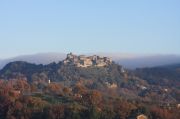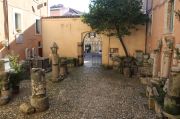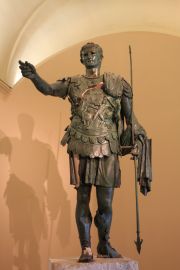Amelia is not along via Flaminia, but very close to it. It is a strategically important town, lying in the south of Umbria, perching on a hill overlooking the two most important rivers in Italy, the Tiber River and Nera River.
|
 |
 |
 |
 |
 |
 |
 |
 |
Geographic feature of ancient Italian towns, hilltop
 |
 |
Can you imagine what the oldest Italian town would look like both historically and contemporarily? You may find some answers from this report then.
Amelia claims to be oldest town in Umbria, the so called green heart but still among the backwater area among all the Italian regions. But Umbria is benefiting from this less industrilized and well preserved all the old towns. In this region, medieval towns are everywhere, good place to explore. As far as Amelia is concerned, we could use it as an excellent sample to look at the oldest Italian towns.
1. Historical Feature
Scholars say Amelia was probably founded by a legendary Umbrian king, Ameroe around 1134 BC, even more than 300 years earlier than Rome. And its ancient name is Ameria. The town was later occupied by the Etruscans, and by Romans. It gained political status as a self-governing municipium by the 1st century BC, and the bishopric of Ameria in the 4th century. During the barbaric invasions, the town was badly damaged by the Goths, but was rebuilt by the Lombards who used to control most part of Umbria. And then the Lombards were driven out by the Byzantines. During this period, Ameria became an important stop on a vital alternative route to Via Flaminia, which fell under the control of the Lombards.This alternative route was called Byzantine Way which connected Rome to the exarchate in Ravenna. Throughout the Middle Ages and up to the Italian unification in 1860, Amelia remained within the Papal States. from the history of Amelia, you may find out that the town's history is the history of the whole Italy or probably western Europe. They are so closely connected, if you failed to look at them together, you would not have a complete picture both of the town and of Italy. Italian history is materialized by those small towns.
2. Geographical Feature
Geographically, if I can not say all, but at least all the historically important ancient towns in Italy were built on the top of hills.
[continue]
|
|
| Favourite spots: |
This hilltop nature lends strong support to the Chinese old saying that human beings selected places before they finally settled down. In order to protect themselves and be better positioned to fight against attacks from others, ancient Italians chose the hilltop to built their families. This geographic nature again has a strong connection with long lasting wars between cities, it is part of history.
3. Heritage Feature
Both the historical and the geographical feature of the ancient italian towns left important footprints, which became the invaluable heritage owned not only by the town, but also by Italy as well as the whole world. Normally heritages from the ancient Italian towns include the following things:
(1) Cathedral
If we say the town is the phisical residence of Italians, church would be their spiritual home. Both are extremely important, and to some extent church is even more important than the phisical symbol, that's why we have pilgrims.
[continue]
|
|
| What's really great: |
Italian towns possess more than one churches, but there is only one that can be called duomo or cathdral. Amelia's cathedral was built originally in 872, and totally rebuilt in Baroque style after a fire in 1629. It said that its facade is of pink cotto, but I did not got a chance to see it, because it was under renovation when I visited. The interior houses great works by Feredico Zuccari, Lavinia Fontana, Agostino di Duccio. But what's more impressive is the 30-meter-high Torre Civia (Civic Tower) on the main square where the cathedral is also housed. It is so outstanding that makes the cathedral look quite humble and small.
Like any other Umbrian Towns, Amelia aslo has a church for the saint who was originally from this region, San Francesco. Chiesa di San Francesco is in Piazza Vera. The church was built in 1287, later a cloister and a convent beside it were added in the 14th century. It is capped with an impressive dome and a bell tower.
[continue]
|
|
| Sights: |
There is another church in Amelia quite impressive, Sant'Agostino in Via Cavour. It consecrated in 1288, almost the same time as San Francesco. It has a Romanesque facade with a Gothic overlay. There is pink courtyard beside it wich loggia with corinthian columns. Very nice but it is discolored, make it feel abandoned. The church also has a very stunning bastion, from where you may visit another site, a Benedictine Monastery for cloistered nuns, S. Magno, but it was also under renovation and not allowed to enter. But I still pretended not to see it and have a quick look, but I retreated immediately, because I saw a nun staring at me.
(2) main square
Ancient Italian towns normally have one main square which houses its cathedral and its town hall. But there are some exceptions, in many bigger towns the cathedral and the town tall are located at different squares. Amelia is such a case, its cathedral is in piazza del duomo while its town hall is in another square.
[continue]
|
|
| Accommodations: |
 |
 |
 |
 |
 |
 |
 |
 |
Town Hall and its courtyard, another Archaeological museum
 |
 |
Piazza del duomo can be counted as the real heart of the town, because it is the zenith of the hill and houses the most important spiritual symbol of the town, the Cathedral, where you may have marvous panorama of the town as well as the whole surrounds.
The main square which houses the town hall is called Piazza Matteotti. You may have a look at the town hall, which works really like an archaeological museum, because they put a lot of statues, I am not sure whether they are from excavation, as a decoration. very cute! Another thing at this main square is the Roman Cisterns, it is a complex of ten underground cisterns built in the 1st century AD and used to collect rain water to feed the town's water supply. It was closed during my visit, but it was a well-known thing in Amelia that you should not miss.
There is another main square, Piazza Augusto Vera, which houses not only the San Francesco church, but also the Archaeological Museum and the Pinacoteca Comunale.
[continue]
|
|
| Nightlife: |
 |
 |
 |
 |
 |
 |
 |
 |
Statue of Germanicus in Archaeological Museum
 |
 |
The Archaeological Museum houses the linchpin of the town, a bronze statue of Germanicus, which was unearthed just outside of the town's main doorway, Porta Romana. It was very delicated, but when it was found, it was already broken into pieces, there are some illumination in the museum to show you how the experts put them together. The ticket is a little bit expensive, 5 Euro, but deserves. Camera is not allowed, but I still managed to take one for you, please do not tell the museum. The museum has also a very nice courtyard, with cloisters, very italian.
|
|
| Hangouts: |
(3) Ancient Walls and Doorways
Almost all the well preserved ancient Italian towns keep their ancient walls or doorways, therefore wall and doorways can serve as an important proof to test the anquity of the italian towns.
Wikipedia says the best seller point of Amelia is its walls. The walls run about 720 meters and about 3.5 meter thick and reach a height of over 20m in some places, and parts of may date to Amelia's earliest days. The most impressive part is that one around its main doorway, Porta Romana.
There are four main gates with each direction having one, Porta Romana to the south, the main access to the town; Posterola to the north; Porta Leone to the east; and Porta della Valle to the west. But I like Porta della Valle the most, where you might have a stunning view of the valley, the wall, the grove trees as well as small river and a bridge across it shining in the sun.
|
|
| Restaurants: |
(4) Amphitheater
As explained in my various previous reports on Italy, if the town has an amphitheater, it would be usually put in much higher ranking. Unfortunately Amelia does not have an amphitheater.
(5) Historic buildings
Historic buildings are also important monuments to test the ages of the towns. Amelia has numerous historic buildings. The city map markes 12 places as historic buildings, Colonna, Venturelli, Geraldini, etc. But the most impressive ones are those at Piazza Marconi, Petrignani, Nacci and the one near the cathedral, Vescovile.
(6) Streets
I also use streets as an criterion to test the italian towns. Because if the towns are well preserved, they need to keep the streets first.
Amelia keeps most of its ancient streets. on the main street, via della Repubblica, you might say one orignal stretch of the roads, built with big rocks. Via Garibaldi, Via cavour, Via Farrattini are also very nice, but I like this small street Via Studiosi most.
|
|
| Other recommendations: |
I have several suggestions for you:
1. on transport. I think there is not direct train service for Amelia based on these two presumptions: one is I did not see any train station there. The other is that last time when I visited Narni, my ticket shows the station is Narni-Amelia, I suppose you need to get off at Narni and then change the bus service from the Narni station.
2. On wandering around the town. Looking at the roadmap of the town is a disaster. Because the town is full of ups and downs, and the road is quite different from what see from the map, therefore you need to take your time. It does need to make necessary efforts to explore any hilltop town, like Amelia. Most of time, I was confusing at the road, how to get there and come back. Take it easy, you will make it.
3. I am going to establish an album for Amelia, you may find more there.
|
|
Published on Friday December 19th, 2008
|
|
 Publish on Facebook
Publish on Facebook
|
Sat, Dec 20 2008 - 10:31 AM
 by pesu
| Think it isn't a mistake to handle the format freely and to create individual criteria to tell everything one considers to be important. I always get the impression Yuliang openly speaks about what he likes or not. |
Fri, Dec 19 2008 - 01:12 PM
 by krisek by krisek
| Thank you Yuliang for your contribution to GLOBO. I can see that you made a routine not to stick to the report format :) Anyway, it is interesting to read about Amelia, but I cannot sense much of your personal feelings about the place. Did you like it? Yes, No? How much? It would be great if you could also provide some more information about accommodation options (you might have spotted hotels, hostels, etc even if did not stay overnight) and places to eat or sit down and relax over a drink or two, if only for a cappuccino. Otherwise, the report becomes more of a travel log. You see, I think members also look into the report to find some practical information, unless you can point them into your travel tips you create on GLOBO separately. I was not sure how many stars I should allocated to this report (I was thinking 4* maybe), but I had a look at some older reports, which were given 4* and 5* and they were much less interesting, a lot shorter and ambivalent. So, here they are - 5* |
Fri, Dec 19 2008 - 10:15 AM
 by jorgesanchez by jorgesanchez
| With every of your new reports, your text and pictures are becoming better and better. Congratulations! |
| Information: |
| Login if you are a member, or sign up for a free membership to rate this report and to earn globo points! |
|
| Italy |
|
|
|
|
|
|
|
|
|
|
|
|
|
|
|
|
 |
| Spain |
|
|
|
|
|

|
